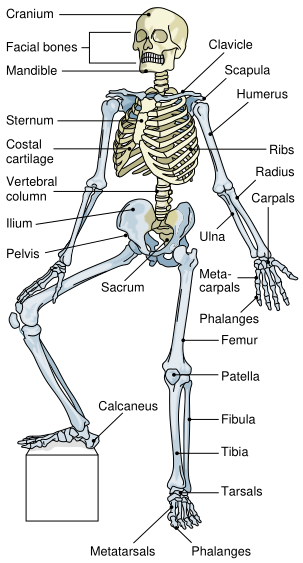The skeleton forms the framework of the body, protects vital organs, and works with the muscular system to produce movement. The human adult skeleton is composed of 206 bones. It is divided for study into the axial skeleton and the appendicular skeleton (Fig. 1).

FIGURE 1. The skeleton. The axial skeleton is shown in yellow; the appendicular skeleton is shown in blue. (Reprinted with permission from Cohen BJ, Wood DL. Memmler's The Human Body in Health and Disease. 9th Ed. Philadelphia: Lippincott Williams & Wilkins, 2000.)
The axial skeleton consists of the skull, the spinal column, the ribs, and the sternum. The skull consists of eight cranial bones and the 14 bones of the face. Skull bones are joined by nonmoveable joints (sutures), except for the joint between the lower jaw (mandible) and the temporal bone of the cranium, the temporomandibular joint (TMJ). As shown in Figure 2, the 26 vertebrae of the spinal column are divided into five regions: cervical (7); thoracic (12); lumbar (5); the sacrum (5 fused); and the coccyx (4 to 5 fused). Between the vertebrae are disks of cartilage that add strength and flexibility to the spine.

FIGURE 2. Vertebral column from the side. (Reprinted with permission from Cohen BJ, Wood DL. Memmler's The Human Body in Health and Disease. 9th Ed. Philadelphia: Lippincott Williams & Wilkins, 2000.)
责任编辑:admin
上一篇:医学文章阅读——Structure of a Long Bone
下一篇:医学文章阅读——The Neuron

微信公众号搜索“译员”关注我们,每天为您推送翻译理论和技巧,外语学习及翻译招聘信息。